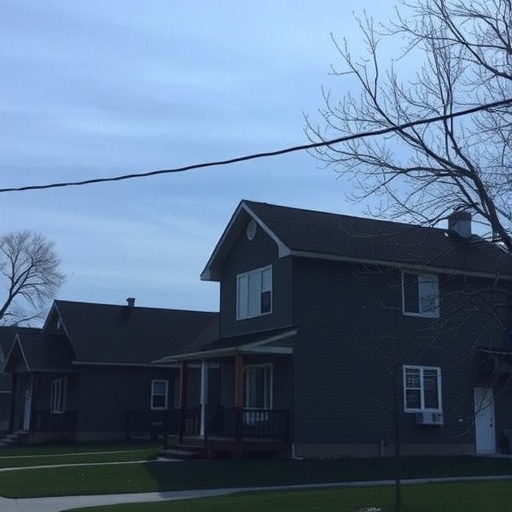A groundbreaking study recently published in Energy Research & Social Science reveals a concerning energy disparity impacting minority households across the United States. Led by Associate Professor George Homsy of Binghamton University, State University of New York, the comprehensive analysis uncovers that Black American communities shoulder a disproportionately high share of their household income to meet basic energy needs. This research offers new insights into how race intersects with income and housing characteristics, shaping energy affordability challenges in ways that have long been overlooked.
Energy burden—the proportion of a household’s income spent on essential energy services such as heating, cooling, lighting, and cooking—serves as a critical lens through which this issue is studied. Using data from over 65,000 census tracts nationwide, the study illuminates stark inequalities. Although the average American household dedicates roughly 3.2 percent of its income to energy expenses, predominantly African American neighborhoods face an average energy burden of 5.1 percent. Latinx communities are also disproportionately affected, albeit to a slightly lesser extent, emphasizing the pervasive nature of this problem across multiple minority groups.
Unlike previous research focusing solely on income disparities, this study delves into the often overlooked spatial and structural factors that exacerbate energy inequities. Professor Homsy stresses that the elevated energy burden in minority communities cannot be explained by income alone. Instead, systemic factors related to residential environments—older housing stock, elevated rental rates, and limited opportunities for energy efficiency improvements—play a decisive role. This suggests that the legacy of discriminatory housing policies continues to impose hidden energy costs on vulnerable populations.
Older homes, common in minority-populated neighborhoods, frequently suffer from inadequate insulation and outdated appliances, which greatly increase energy consumption. High rental occupancy rates in these areas compound the problem, as renters usually lack the authority or incentive to initiate energy-saving renovations or upgrades. This structural barrier traps residents in a cycle of high energy costs, undermining their financial stability and well-being.
The implications of this energy inequity extend far beyond financial strain. An excessive energy burden can force families to make difficult choices, such as forgoing medical treatment, reducing healthy food consumption, or limiting transportation – necessities critical to quality of life. Compounding these challenges, the timing and intensity of energy expenses are often unpredictable, increasing economic stress for households already managing tight budgets.
Professor Homsy emphasizes the necessity of considering both income and race as intertwined factors when addressing energy poverty. For instance, middle-class African American families still confront higher energy burdens compared to their white counterparts, highlighting the persistence of entrenched disparities regardless of economic status. This insight challenges conventional narratives that attribute energy hardship purely to poverty, urging policymakers to adopt a more nuanced approach.
Policy interventions, according to the research, must prioritize minority communities facing outsized energy burdens due to historical and systemic inequities. Targeted programs aimed at improving the energy efficiency of rental housing stock and providing resources tailored to the unique challenges renters face are crucial. Engaging local sustainability officials and community organizations is equally important, as they can facilitate access and trust within neighborhoods where traditional outreach efforts frequently fall short.
Ongoing studies by Homsy and colleagues further investigate how sustainability and energy equity initiatives can be effectively implemented, particularly in rental-heavy areas where many energy burdens persist. Early findings suggest obstacles in reaching these populations include regulatory barriers, fragmented responsibilities between landlords and tenants, and limited funding streams, all of which complicate efforts to improve energy conditions in minority communities.
The research underscores the intricate interplay of socioeconomic, racial, and spatial dynamics influencing energy burdens. It reveals how systemic inequities—rooted in historical housing discrimination—translate into contemporary energy insecurity. This study is a clarion call to reexamine energy policy through an equity lens, recognizing that technical solutions alone cannot resolve problems born from structural injustice.
By addressing these disparities, policymakers have an opportunity to significantly reduce health and economic inequities among minority populations. Investments in energy efficiency and affordability targeted at historically marginalized communities could alleviate financial pressures and promote environmental justice. Moreover, such efforts would contribute to broader social goals related to sustainability and community resilience.
In sum, this pioneering study provides compelling evidence that the burden of powering a home weighs unevenly across America’s racial and economic landscape. The detailed statistical analysis led by Binghamton University’s George Homsy reveals a multifaceted problem requiring comprehensive, equity-focused solutions. As the nation confronts the dual challenges of energy affordability and racial justice, this research offers critical guidance for crafting policies that ensure all households can power their homes without disproportionate financial sacrifice.
Subject of Research: People
Article Title: Energy burden: Exploring the intersection of race, income, and community characteristics across the United States
News Publication Date: 10-Jul-2025
Web References:
Image Credits: Power lines poles by Matthew Paul Argall, licensed under CC BY 2.0.
Keywords: Racial inequality, Social inequality, Society, Sociology, Microeconomics, Socioeconomics, Energy resources




